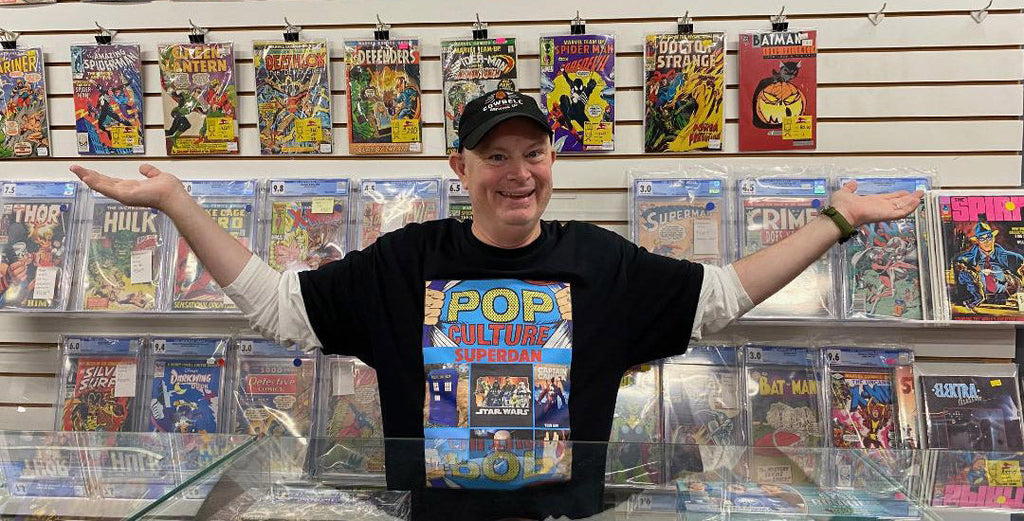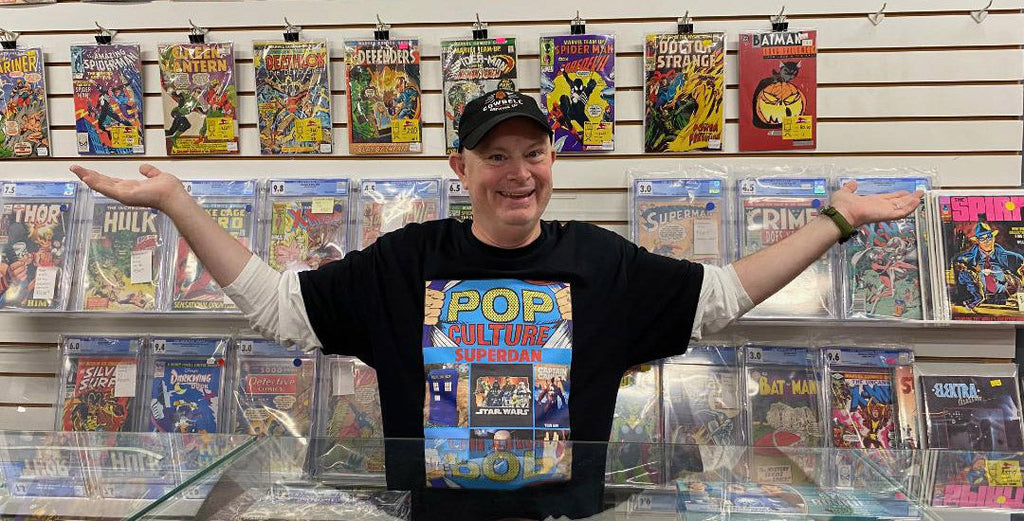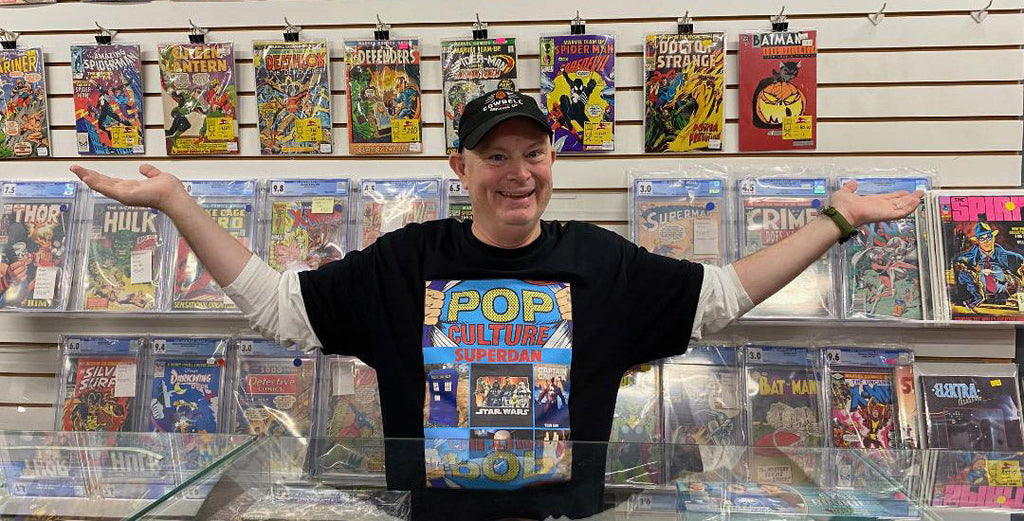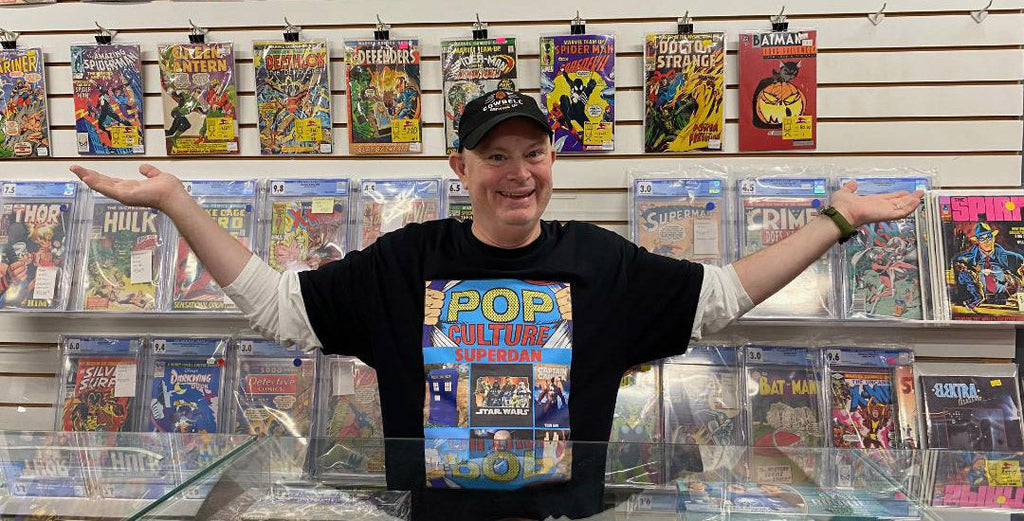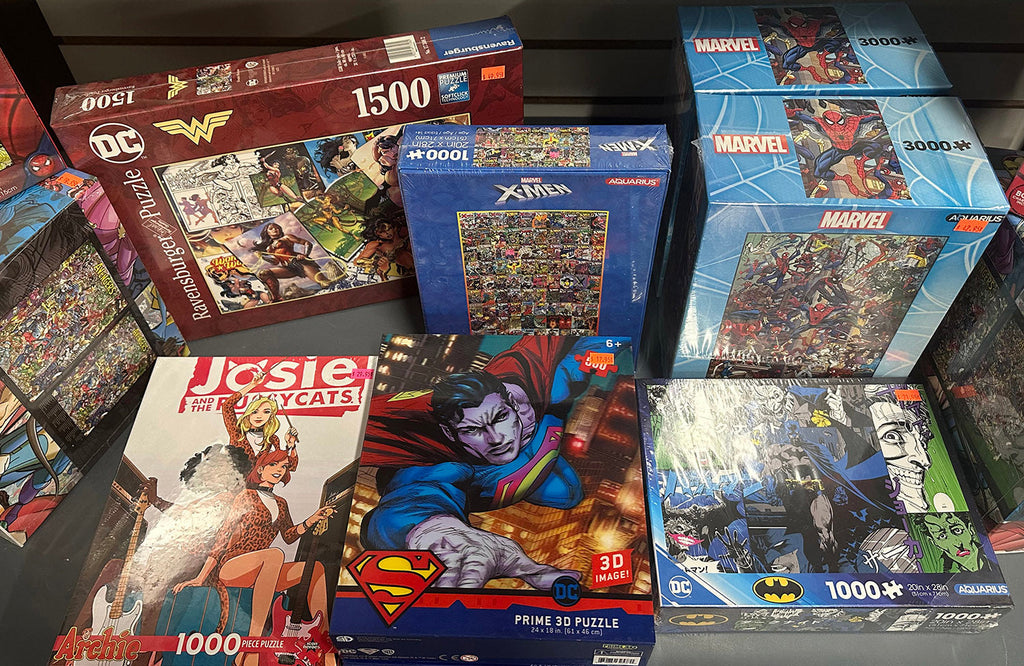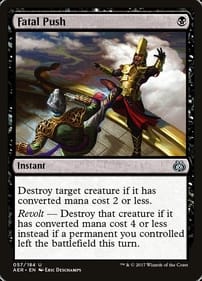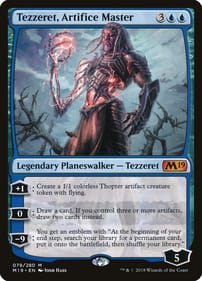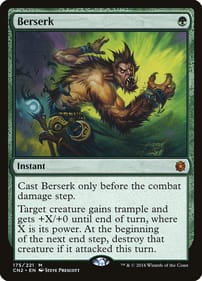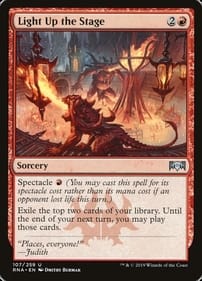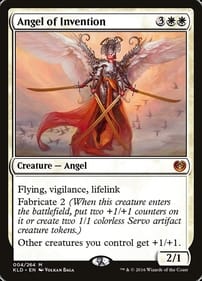Enjoy Free Comic Book Day
By Dan Brown Here’s some free advice. Do yourself a favour this weekend and make time on Saturday to head down to 100 Kellogg Lane for Free Comic Book Day at L.A. Mood Comics & Games. It’s the annual event held at comic stores everywhere when retailers offer freebie sampler comics to their customers, as well as putting on sales that include some outrageous discounts. It kicked off in 2002 and quickly became an institution among those whose who have nerdy tastes. It grew into what some have dubbed “geek Christmas.” “This event celebrates the independent comic book specialty shops, thousands of which exist in North America alone,” organizers explain on Free Comic Book Day’s official website. And here in London, it’s always had its own flavour with store owners marking the day in their own distinct way. At L.A. Mood, for instance, local comic creator Eric Olcsvary will be holding court. “Eric is an extremely talented indie comic creator and an all-around delightful human being. Make sure you stop by his table to say ‘Hi’ and check out his comics,” the folks at L.A. say. Olcsvary is known for his AllsCherryComics line, including his Wendy series. The store is also teaming up with Shaw’s Ice Cream, located on the second floor of 100 Kellogg, for a contest that will test the creativity of comic-book fans, who are asked to rename an existing Shaw’s ice-cream flavour using a comic book or superhero reference (without using trademark names). I know my favourite is maple walnut. Now how could I make that into a comic-themed flavour . . . The publishers giving away samplers of their titles this year include Marvel, Dark Horse, Image, Random House Children’s Books, Boom! Studios, and Archie. The one title that caught my eye on the FCBD site is Marvel’s Fantastic Four offering. “(Writer) Ryan North and (artist) Humberto Ramos craft an unusual story in which the Fantastic Four respond to a most unusual interdimensional summons!” the bumpf for the issue exclaims. Sounds like classic FF! The freebie comes, of course, as Marvel Studios prepares to launch Fantastic Four: First Steps on the big screen at the end of July. What I love about Free Comic Book Day, apart from the deals, is the feeling that’s in the air as comic fans travel to the Forest City’s comic stores. Spring is arriving, university classes are over, the world is just coming back to life after the winter. Comic fans are getting primed for the summer’s big movie releases, and cosplayers often have new outfits to wear. The first Saturday in May wouldn’t be the same without it. You may have heard how the owner of the Free Comic Book Day brand, the comics distributor Diamond, entered Chapter 11 earlier this year. I don’t think there’s any need to fret. The day has become its own special thing, and if Diamond doesn’t survive I have no doubt that comic stores would step in to keep the tradition alive, even without the distributor acting as coordinator. I hope to see you on Saturday! Dan Brown has covered pop culture for more than 32 years as a journalist and also moderates L.A. Mood’s monthly graphic-novel group.
What’s with All the Facsimile Editions?
By Dan Brown Comic reprints have been around a long time – in fact, if I recall my industry history correctly, the first comic books were stapled editions of reprinted newspaper funnies. What’s relatively new are facsimile comic editions. They’ve been around a few years and in their current form they reproduce historically significant issues – like, say, the first appearance of the Punisher in Marvel’s Amazing Spider-Man No. 129 – on glossy paper. The other difference is the context. Unlike anthologies of collected issues, facsimiles editions also reproduce the front and back covers, ads, letter columns, and other bumpf that accompanied the original story. I guess the selling point would be, if you want to experience a particular comic as it appeared in, for example, 1974, then this is the closest you’re going to get to it. I'm all for them, just so long as they don’t alter or “correct” any of the content as it appeared originally. I was heartened to see, for instance, that a facsimile of Marvel’s Star Wars No. 1, which came out ahead of the movie’s release in 1977, faithfully reproduces the odd colour scheme of the comic as it was. So the front depicts Princess Leia as a redhead and Darth Vader’s armour as green. Just like the original weird cover. There would have been no outcry at the time because moviegoers didn’t know any better, with the film’s theatrical debut months off. The adaptation, like the unseen motion picture, was called simply Star Wars, not Episode IV or A New Hope or anything else George Lucas dreamed up after the saga took off. I’m sure the collector market has a lot to do with the proliferation of facsimiles. It’s impossible for most comic fans to buy a copy of Fantastic Four No. 1, for instance, so this is a cheap way to see what the fuss was all about. I own many anthologies and collections, and I will concede they lack something – the ads in comics, especially, were a big part of the reading experience when I first became a fan in the 1970s. Where else can you see ads for weight-GAIN formulas? “Too skinny?” one spot blares in AMS No. 129. In another notice. Charles Atlas promises to make any weakling into a man, and such novelties as X-ray glasses, joy buzzers and stink loads for smokes (“guaranteed to stop cigarette moochers”) were on offer. The colourful adverts of that era also urged readers to take up fishing, eat Slim Jims and snack on Hostess Twinkies. The 1970s being an age of self-improvement when everyone was scrounging for a buck, you could train by mail to be a cartoonist, veterinary assistant, hypnotist or karate master. And if you did respond to any of the offers, “No salesman will call.” Naturally. Likewise, the letters page was a big part of what made comics special. At a time when there was no global instant-communications device, seeing what other fans had to say gave me new ways of thinking about my favourite heroes. Back then, the letters column was the hub that joined individual readers to the larger Marvel or DC fan community, confirming for me that other kids were moved by the same characters and plots. Perhaps the appropriate way to describe facsimile issues is that they are the equivalent of watching YouTube videos of old TV shows with the commercials included. The only misleading bit is the paper itself. Facsimile editions are printed on glossy stock and the borders surrounding the panels on each page are a blinding white. Even with freshly printed comics back in the day, the newsprint was one splotchy shade of brown or another, and aged rapidly. These things were not built to last. So enthusiasts in 2025 will miss one out on one very important comic experience from the past: Inhaling the sweet, musty scent that comics made with cheap paper give off as they decay over the years. It may be my favourite smell. If I could bottle it, I would. Dan Brown has covered pop culture for more than 32 years as a journalist and also moderates L.A. Mood’s monthly graphic-novel group.
Pop Culture Like Star Trek Used to be Disposable Fluff
By Dan Brown When I say “Star Trek,” I mean the old TV show that featured William Shatner as Captain Kirk and Leonard Nimoy as Mister Spock. I don’t mean the Next Generation or Voyager or Upper Decks or Strange New Worlds or anything else. And if you’ve seen a Star Trek rerun in the last few years, you’ll have noticed the special effects stand up remarkably well. Although it was made on a shoestring budget in the late 1960s for an audience that had low expectations of science-fiction television, those shots of the Enterprise look crisp. But here’s the thing: Those aren’t the original effects. When you see the Enterprise floating in space, fighting a battle, or high above a planet’s surface, those images were inserted into the original episodes in a remastering process that dates back only to 2006. So the Trekkies who fell in love with the series in the 1960s did so without the attraction of modern special effects. My purpose here isn’t to argue which version is better. Nor is it to speculate if Star Trek creator Gene Roddenberry would have approved of the new effects (he died in 1991). What I want to point out is how the revised Star Trek episodes represent a new attitude toward pop culture. What would surprise Roddenberry if he were alive is how long-lived his show has been. When the program originally aired from 1966 to 1969, TV didn’t have a great reputation. The medium was derided as “the boob tube” because the dominant perception was that the small screen appealed to those who weren’t all that bright. Consequently, Star Trek – which many consider classic stuff today – was just as disposable as any other show on the air at the time. In other words, despite embodying enduring social and political themes, individual episodes weren’t built to last. It didn’t matter back then if the show would hold up to repeated viewings, and I’m guessing the idea people would still be watching Star Trek in the year 2025 would have startled network executives. Nor is Star Trek the only example of pop culture that was created as ephemera that has far outlasted its creator’s intentions. Star Wars (by which I mean the movie with that title that came out in 1977) was made at a moment when few moviegoers were willing to pay to see a particular film multiple times. After all, a child’s ticket went for a whopping $1.50! Who could afford that in the hardscrabble Seventies, no matter how much you loved a film? As you likely know, several new coats of digital paint have been applied to Star Wars in the interim. There were versions with enhanced sound effects, then versions with enhanced visual effects, and on and on. They may have even released a 3D Star Wars for all I know. It doesn’t stop there. There are also updated editions – with outtakes put back in – of novels like George Orwell’s Nineteen Eighty-Four and Stephe King’s ’Salem’s Lot. Albums such as Bob Marley’s Legend have likewise been retouched. The important thing to note here is our feelings about pop culture like the original Star Trek series have changed: What was once a throwaway indulgence meant only for a moment’s pleasure is now taken seriously, even expected to transcend its time. Heck, there are even such journalists as Rob Salkowitz who specialize in writing about pop culture! That didn’t used to happen. Expectations have risen dramatically. You could even argue it’s pop culture like Star Trek and Star Wars that is partly responsible for creating an audience that wants more out of its TV, movies, music and so on, than a momentary distraction. Me, I prefer the “original” versions of things that were released back in the day. To my eyes, the first Star Wars motion picture had a certain low-budget charm so I didn’t need a new, “better” one. But I’m glad it’s still around, even in a modified form, to light the fire of imagination in the minds of a new generation of pop-culture enthusiasts who have higher expectations than I ever did. Dan Brown has covered pop culture for more than 32 years as a journalist and also moderates L.A. Mood’s monthly graphic-novel group.
Pop Culture Like Star Trek Used to be Disposable Fluff
By Dan Brown When I say “Star Trek,” I mean the old TV show that featured William Shatner as Captain Kirk and Leonard Nimoy as Mister Spock. I don’t mean the Next Generation or Voyager or Upper Decks or Strange New Worlds or anything else. And if you’ve seen a Star Trek rerun in the last few years, you’ll have noticed the special effects stand up remarkably well. Although it was made on a shoestring budget in the late 1960s for an audience that had low expectations of science-fiction television, those shots of the Enterprise look crisp. But here’s the thing: Those aren’t the original effects. When you see the Enterprise floating in space, fighting a battle, or high above a planet’s surface, those images were inserted into the original episodes in a remastering process that dates back only to 2006. So the Trekkies who fell in love with the series in the 1960s did so without the attraction of modern special effects. My purpose here isn’t to argue which version is better. Nor is it to speculate if Star Trek creator Gene Roddenberry would have approved of the new effects (he died in 1991). What I want to point out is how the revised Star Trek episodes represent a new attitude toward pop culture. What would surprise Roddenberry if he were alive is how long-lived his show has been. When the program originally aired from 1966 to 1969, TV didn’t have a great reputation. The medium was derided as “the boob tube” because the dominant perception was that the small screen appealed to those who weren’t all that bright. Consequently, Star Trek – which many consider classic stuff today – was just as disposable as any other show on the air at the time. In other words, despite embodying enduring social and political themes, individual episodes weren’t built to last. It didn’t matter back then if the show would hold up to repeated viewings, and I’m guessing the idea people would still be watching Star Trek in the year 2025 would have startled network executives. Nor is Star Trek the only example of pop culture that was created as ephemera that has far outlasted its creator’s intentions. Star Wars (by which I mean the movie with that title that came out in 1977) was made at a moment when few moviegoers were willing to pay to see a particular film multiple times. After all, a child’s ticket went for a whopping $1.50! Who could afford that in the hardscrabble Seventies, no matter how much you loved a film? As you likely know, several new coats of digital paint have been applied to Star Wars in the interim. There were versions with enhanced sound effects, then versions with enhanced visual effects, and on and on. They may have even released a 3D Star Wars for all I know. It doesn’t stop there. There are also updated editions – with outtakes put back in – of novels like George Orwell’s Nineteen Eighty-Four and Stephe King’s ’Salem’s Lot. Albums such as Bob Marley’s Legend have likewise been retouched. The important thing to note here is our feelings about pop culture like the original Star Trek series have changed: What was once a throwaway indulgence meant only for a moment’s pleasure is now taken seriously, even expected to transcend its time. Heck, there are even such journalists as Rob Salkowitz who specialize in writing about pop culture! That didn’t used to happen. Expectations have risen dramatically. You could even argue it’s pop culture like Star Trek and Star Wars that is partly responsible for creating an audience that wants more out of its TV, movies, music and so on, than a momentary distraction. Me, I prefer the “original” versions of things that were released back in the day. To my eyes, the first Star Wars motion picture had a certain low-budget charm so I didn’t need a new, “better” one. But I’m glad it’s still around, even in a modified form, to light the fire of imagination in the minds of a new generation of pop-culture enthusiasts who have higher expectations than I ever did. Dan Brown has covered pop culture for more than 32 years as a journalist and also moderates L.A. Mood’s monthly graphic-novel group.
Here’s a Bunch of Mini-Reviews
By Dan Brown Here’s the lowdown on a stack of comics I bought recently. There’s no logic to the choices, other than each cover struck my fancy while I was browsing the new-releases wall at L.A. Mood. Fantastic Four No. 29: Perhaps I have a case here to sue Marvel for bait-and-switch. I picked this one based on the cover, which promises an out-of-continuity tale answering the question, “What if . . . Mickey & friends became the Fantastic Four?” I was intrigued by the idea of Goofy switching places with the ever-loving Thing. As it turns out, it was a variant cover. Instead, I got a Ryan North/Cory Smith joint titled The Dream Team about Doctor Doom taking over . . . everything. This looks to be Marvel’s event series this summer, One World Under Doom, and I applaud the House of Ideas for taking this one on, if only because they are going to get so much blowback from Trump fans claiming it’s a metaphor for the current situation in the U.S. The FF goes to bat for the downtrodden . . . who in this case are vampires left over from the previous event series. Doctor Doom & Rocket Raccoon No. 1: I love the movie Rocket more than the comic Rocket, so in my mind I read his dialogue in Bradley Cooper’s voice. I haven’t read a J. Michael Straczynski-penned story in a long time, and this one is long on philosophy, short on action. Doom partners with the genetically engineered rodent to help him delve into the origins of . . . everything. Essentially, the Latverian ruler wants to travel back in time to a time before time. That is, before the Big Bang. I give Doom props for recognizing that a lowly raccoon is almost his mental equal. And one page features a Jack Kirby-esque collage, which is a bonus. What do they discover in preshistory? “The purpose of the universe is to understand the purpose of the universe.” It’s one of them paradoxes. Godzilla vs. Fantastic Four No. 1: This is easily the best-illustrated issue among my purchases, featuring John Romita Jr. art based on a Ryan North script. Marvel takes the existing Marvel continuity and fuses it with the Toho storyline, as happened with the original Marvel series about the fire-breathing unfrozen dinosaur. Reed even tips his hat to Dr. Daisuke Serizawa’s oxygen destroyer in the opening panels. One cool concept in this issue sees Godzilla foe King Ghidorah taking on the power cosmic in his role of herald of Galactus. And yes, it’s all leading up to an eventual battle between the Tokyo-demolisher and the world-devourer. Godzilla Heist No. 1: If you’re a fan of Godzila, this is truly an awesome time to be alive because you can read about him in more than one company’s comics. This IDW-published series reads sort of like what would happen if Quentin Tarantino directed a kaiju flick. As powerful as Godzilla is, here his rampages are just a massive distraction for a ring of human thieves who, naturally, don’t know which one of them might betray the others.The story begins with the big G destroying a casino, which is certainly one way to make sure the authorities don’t pay attention to your scheme to plunder their treasures. Godzilla vs. Chicago One Shot: As part of the Godzilla vs. America series, local creators get a stab at fitting Godzilla into their own community’s neighbourhoods, politics, and culture. Also part of IDW’s current offerings, it’s really just an excuse to pay tribute to old-school comic sound effects such as:Dong donk!Zang!Zong!Choom!Fwomp! Fwooosh! Shreeonk!What can I say? I know what I like. Daring the Sun No. 2 by Forest City creator Scott Brian Woods: Called Crash Down, this tale of an astronaut traveling through the heart of a sun is “inspired by imagination comics of the past, science fiction, and a deep love of old-school adventure, sci-fi fantasy space operas.” The Kirby Crackle on the opening splash page jumped out at me, and the drawing on the back cover shows the pilot in a Flash Gordon-esque outfit with an old-school raygun. Somehow, he is connected to a warrior named Vala, who fends off dinosaur-like aliens in a barren landscape. If you like classic George Lucas intercutting, you will love the structure of this piece, ending naturally with a cliffhanger. Moon Girl and Devil Dinosaur 10th Anniversary Special No. 1: I don’t know how, exactly, Lunell Lafayette got a hold of the ultimate nullifier, but it’s one of the items she brings to her surprise 10th birthday party in New York. A back-of-the-book story flashes forward to when Moon Girl has grown into Moon Woman, and she visits Earth from the orbiting satellite. Senior Marvel Editor Mark Paniciccia says the series has lasted a decade because “it’s inspired young readers to embrace their individuality and believe in their potential.” Or maybe they just really like to groove on the blood-red T-Rex who is Moon Girl’s constant companion. What comics or graphic novels have you been reading lately? I’d love to hear about it in the comment box below! Dan Brown has covered pop culture for more than 32 years as a journalist and also moderates L.A. Mood’s monthly graphic-novel group.
Puzzle Sale
Save 40% Offon All Jigsaw PuzzlesIn Store or Online! (April 25 - May 4) Save on modern comic, Harry Potter, and Star Wars puzzles, to classic scenic Cobble Hills puzzles. Are you still puzzled? Come in the store or order online to save. Set your calendar and be prepared to take advantage of this sale.


